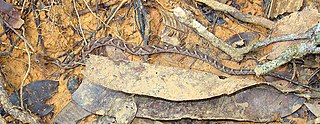
Colubridae is a family of snakes. With 249 genera, it is the largest snake family. The earliest fossil species of the family date back to the Late Eocene epoch, with earlier origins suspected. Colubrid snakes are found on every continent except Antarctica.

Skinks are lizards belonging to the family Scincidae, a family in the infraorder Scincomorpha. With more than 1,500 described species across 100 different taxonomic genera, the family Scincidae is one of the most diverse families of lizards. Skinks are characterized by their smaller legs in comparison to typical lizards and are found in different habitats except arctic and subarctic regions.

Achille Valenciennes was a French zoologist.

George Albert Boulenger was a Belgian-British zoologist who described and gave scientific names to over 2,000 new animal species, chiefly fish, reptiles, and amphibians. Boulenger was also an active botanist during the last 30 years of his life, especially in the study of roses.
Robert Friedrich Wilhelm Mertens was a German herpetologist. Several taxa of reptiles are named after him. He postulated Mertensian mimicry.

Apalone is a genus of turtles in the family Trionychidae. The three species of Apalone are native to freshwater habitats in North America; they are the only living softshell turtles from the Americas.

Dendrophidion is a genus of New World colubrid snakes commonly referred to as forest racers.

Diploglossidae is a family of anguimorph lizards native to the Americas, with most genera being endemic to Hispaniola. Most members of this family are known as galliwasps. They were formerly considered a subfamily of Anguidae, but genetic evidence has shown them to be less closely related to other members of Anguidae than Anniellidae is.
The Reptile Database is a scientific database that collects taxonomic information on all living reptile species. The database focuses on species and has entries for all currently recognized ~14,000 species and their subspecies, although there is usually a lag time of up to a few months before newly described species become available online. The database collects scientific and common names, synonyms, literature references, distribution information, type information, etymology, and other taxonomically relevant information.

Dendrophidion percarinatum, commonly known as the South American forest racer, is a snake of the colubrid family.
Dendrophidion paucicarinatum, commonly known as Cope's forest racer, is a snake of the colubrid family.
Dendrophidion bivittatus, commonly known as the forest racer, is a snake of the colubrid family.

Dendrophidion dendrophis, also known by its common name olive forest racer, is a species of snake from the genus Dendrophidion.
Dendrophidion atlantica, the Atlantic forest racer, is a species of non-venomous snake in the family Colubridae. The species is found in Brazil.
Dendrophidion boshelli, Hoshell's forest racer, is a species of non-venomous snake in the family Colubridae. The species is found in Colombia.
Dendrophidion brunneum, Günther's forest racer, is a species of non-venomous snake in the family Colubridae. The species is found in Peru and Ecuador.
Dendrophidion graciliverpa, the west Ecuadorian forest racer, is a species of non-venomous snake in the family Colubridae. The species is found in Ecuador.

Dendrophidion nuchale, Peters's forest racer, is a species of non-venomous snake in the family Colubridae. The species is found in Venezuela.
Dendrophidion prolixum is a species of non-venomous snake in the family Colubridae. The species is found in Colombia and Ecuador.
Dendrophidion vinitor, the barred forest racer, is a species of non-venomous snake in the family Colubridae. The species is found in Mexico, Belize, and Guatemala.








